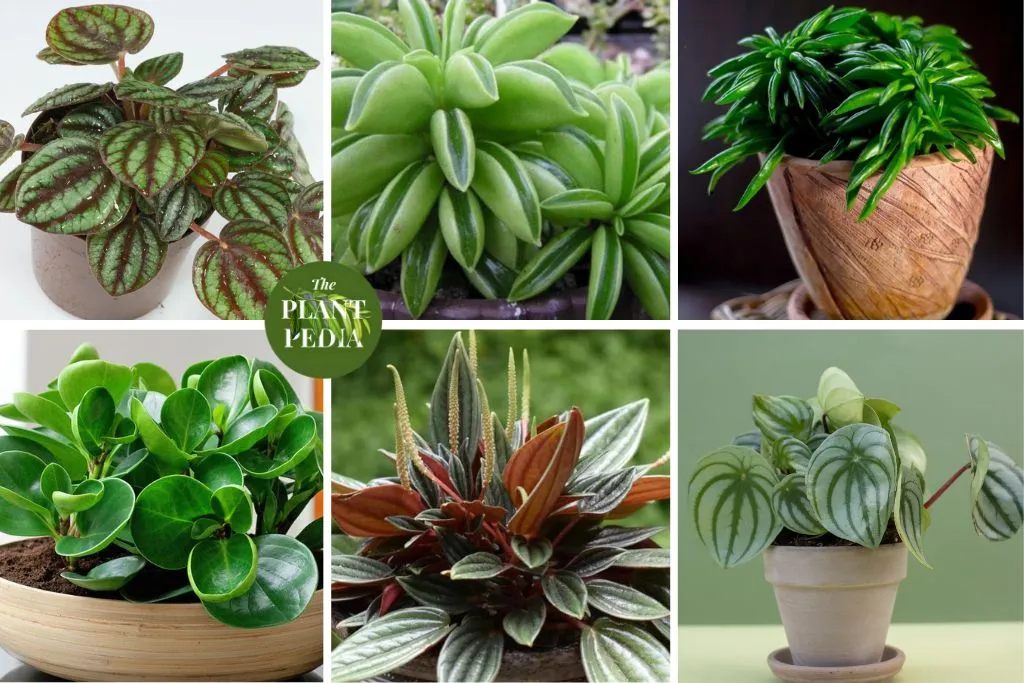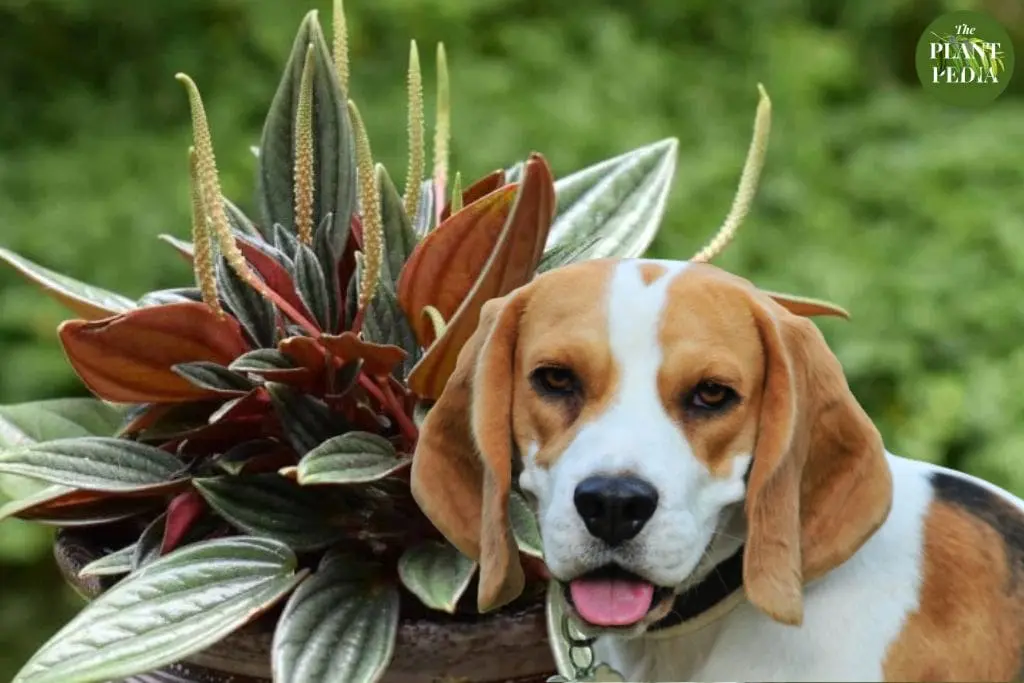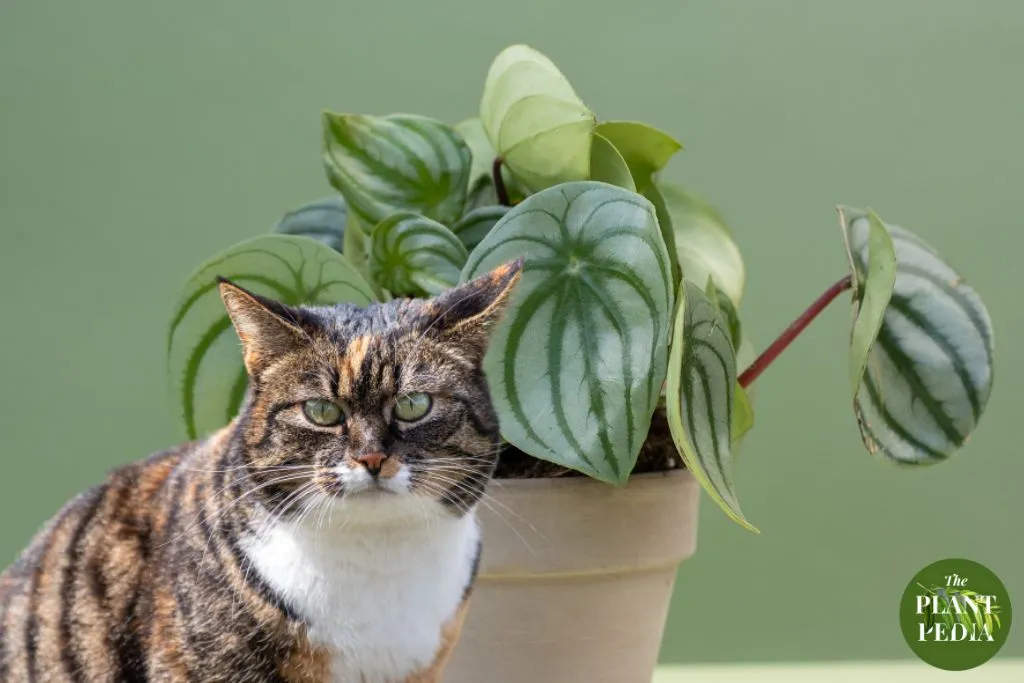In the world of indoor gardening, peperomia plants have captured the hearts of many plant enthusiasts.
With their charming and colorful foliage, these plants are not only aesthetically pleasing but also known for their ability to thrive in various indoor conditions.
However, for pet owners, the concern often arises: Are peperomia plants toxic to dogs? In this comprehensive blog post, we will delve into the fascinating world of peperomia plants, exploring their characteristics, their interaction with dogs, and the reasons behind their non-toxic nature.

Table of Contents
Understanding Peperomia Plants
Peperomia is a diverse genus comprising over 1,000 species of flowering plants belonging to the Piperaceae family.
These plants are native to tropical and subtropical regions worldwide, ranging from South America to Africa and Asia.
One of the standout features of peperomias is their distinctive small leaves, which come in various shapes, sizes, and colors, including shades of green, red, and variegated patterns.
This ornamental appeal has contributed to their popularity among indoor plant enthusiasts.

Is Peperomia Toxic to Dogs?
No, peperomia plants are not toxic to dogs. Peperomia plants are considered non-toxic, meaning that if a dog ingests parts of the plant, it is unlikely to result in any significant negative effects.
This is reassuring for pet owners who want to keep both their indoor plants and their dogs safe.
While peperomia plants are generally safe, it’s still a good practice to keep them out of your dog’s reach to prevent accidental ingestion and to monitor your dog’s behavior around plants in case of any unexpected reactions.

Also read: Is Peperomia Toxic to Cats?
Reasons Behind Peperomia’s Non-Toxic Nature
Several factors contribute to the non-toxic nature of peperomia plants for dogs:
Absence of Saponins:
Saponins are naturally occurring compounds found in some plants, and they can be toxic to animals if ingested. Peperomia plants, fortunately, do not contain significant levels of saponins.
This absence of a toxic compound is one of the primary reasons why peperomia plants are safe for dogs.
Waxy Leaf Coating:
The leaves of peperomia plants are coated with a thin layer of wax, which gives them a glossy appearance. This waxy coating serves a dual purpose.
First, it helps in reducing water loss through the leaves, making peperomias well-suited to low-humidity indoor environments.
Second, and importantly for pet safety, this waxy coating makes the leaves unpalatable to dogs.
Even if a curious dog attempts to nibble on the plant, the texture and taste of the leaves are likely to deter them.
Lack of Skin-Absorbed Toxins:
Some plants can be harmful not only when ingested but also when they come into contact with the skin.
Peperomia plants, however, do not produce toxins that can be easily absorbed through a dog’s skin.
This further reduces the risk associated with having these plants around dogs.
Potential Allergic Reactions
While peperomia plants are generally safe for dogs, it’s important to remember that allergies can vary from one individual to another, whether human or canine.
Some dogs might exhibit allergic reactions to plants, including peperomia. Signs of an allergic reaction can include vomiting, diarrhea, hives, or excessive scratching.
If any of these symptoms are observed after interaction with a peperomia plant, it’s crucial to consult a veterinarian promptly.
Creating a Pet-Friendly Environment
Creating a pet-friendly environment is essential for ensuring the well-being of your furry companions while maintaining a harmonious living space.
When it comes to incorporating indoor plants like peperomia into your home, here are some tips to consider:
- Plant Selection: As established, peperomia plants are non-toxic to dogs, which makes them a great choice for pet-friendly homes. However, it’s wise to research any new plant you introduce to your space to confirm its safety for pets. Some common houseplants can be toxic, and it’s best to avoid those to prevent any potential hazards.
- Placement: Strategically place your peperomia plants in areas that are less accessible to your dogs. Elevated shelves, hanging planters, or corners that are less frequented by your pets can be ideal spots. This not only prevents accidental ingestion but also minimizes the chances of your plants being knocked over or damaged during playtime.
- Training: Basic training is important to establish boundaries for your dogs. Teach them commands like “leave it” or “no” to discourage them from exploring or nibbling on plants. Positive reinforcement, treats, and consistent training can help your dogs understand what’s off-limits.
- Chew Toys and Distractions: Dogs have a natural urge to chew, especially during their teething phase. Provide them with appropriate chew toys to redirect their chewing behavior. Engaging toys and puzzles can also help keep their minds occupied, reducing their interest in exploring plants.
- Supervision: Keep an eye on your dogs’ behavior around plants, especially if you’re introducing new ones to your home. Observe their reactions and ensure they are not showing signs of curiosity or attempting to interact with the plants in an unwanted manner.
- Physical Barriers: If you have particularly curious dogs, consider using physical barriers like baby gates or indoor fences to restrict their access to certain areas. This can be especially useful if you have delicate or rare plants that need extra protection.
- Regular Exercise: Dogs that are adequately exercised are less likely to become bored and engage in undesirable behaviors like chewing on plants. Regular walks, playtime, and mental stimulation can reduce the likelihood of your dogs turning their attention to your plants.
- Positive Associations: Create positive associations between your dogs and your plants. Spend time near the plants with your dogs, reward them for good behavior, and make the environment feel comfortable for both them and your plants.
- Grooming and Health: Regular grooming and maintaining your dogs’ overall health can reduce the likelihood of them seeking out plants due to discomfort or irritation. Make sure they have a balanced diet and access to fresh water.
- Consult a Veterinarian: If you notice any unusual behavior in your dogs, such as persistent attempts to interact with plants or signs of digestive discomfort, consult your veterinarian for guidance. They can provide advice tailored to your specific situation.
Remember, creating a pet-friendly environment doesn’t mean sacrificing the beauty and benefits of indoor plants.
With careful planning and attention, you can enjoy the presence of peperomia plants and other greenery while ensuring the safety and happiness of your beloved canine companions.
Related FAQs:
Are Peperomia Plants Toxic to Dogs?
No, peperomia plants are not toxic to dogs. They are considered non-toxic, meaning that if a dog ingests parts of the plant, it is unlikely to result in significant negative effects.
Can Dogs Safely Chew on Peperomia Plants?
While peperomia plants are non-toxic to dogs, it’s still advisable to discourage them from chewing on the plants.
The waxy coating on peperomia leaves can deter dogs from eating them, but excessive chewing could still damage the plant or lead to digestive issues in dogs.
What Should I Do If My Dog Eats a Peperomia Plant?
If your dog ingests a peperomia plant, there’s generally no need to panic. Since peperomias are non-toxic, the likelihood of serious harm is low.
However, it’s always a good idea to monitor your dog for any unusual behavior or symptoms and consult your veterinarian if you have concerns.
Can Dogs Be Allergic to Peperomia Plants?
While peperomias are generally safe for dogs, there is always a possibility of allergies. Some dogs might have sensitivities to certain plants, including peperomias.
If your dog shows signs of an allergic reaction, such as vomiting, diarrhea, or skin irritation, consult your veterinarian.
How Can I Prevent My Dog from Interacting with My Peperomia Plants?
To prevent your dog from interacting with your peperomia plants, consider placing the plants in areas that are less accessible to your dog.
Use elevated surfaces, hanging planters, or indoor barriers to create a safe space for your plants. Additionally, basic training and providing appropriate chew toys can help redirect your dog’s attention away from the plants.
Are There Other Non-Toxic Plants I Can Have Around Dogs?
Yes, there are several non-toxic plants that you can safely have around dogs. Some examples include spider plants, Boston ferns, African violets, and Christmas cacti.
Research any new plant you introduce to your home to ensure its safety for your furry friends.
What Are Some Signs of Plant Ingestion in Dogs?
If your dog has ingested a plant, they might exhibit symptoms such as vomiting, diarrhea, drooling, lethargy, or changes in behavior.
While non-toxic plants like peperomias are unlikely to cause severe reactions, it’s still important to monitor your dog’s well-being and consult a veterinarian if needed.
Are Peperomia Plants Safe for Other Pets, Such as Cats?
Yes, peperomia plants are generally safe for other pets, including cats. They are non-toxic and are unlikely to cause significant harm if ingested.
However, as with dogs, it’s a good idea to prevent excessive plant consumption to avoid potential digestive discomfort.
Can I Use Peperomia Plants to Improve Indoor Air Quality for Pets?
Peperomia plants, like many other houseplants, can contribute to improving indoor air quality by helping to filter out certain pollutants. This can benefit both pets and humans by creating a healthier living environment.
Should I Seek Veterinary Care If My Dog Ingests a Peperomia Plant?
In most cases, ingesting a peperomia plant is unlikely to require urgent veterinary care due to their non-toxic nature.
However, if your dog shows any signs of distress, discomfort, or if you’re unsure about their reaction, it’s always best to consult your veterinarian for professional advice.
Conclusion
In the vibrant world of indoor plants, peperomia species shine as safe and captivating options for dog owners.
Their non-toxic nature, combined with their aesthetic appeal and adaptability to indoor conditions, make them an excellent choice for those who wish to cultivate a beautiful green space while keeping their canine companions safe.
Remember that while peperomia plants are generally harmless to dogs, individual allergies and reactions can vary, so responsible observation and prompt veterinary attention are key to ensuring the health and happiness of both your plants and your furry friends.

